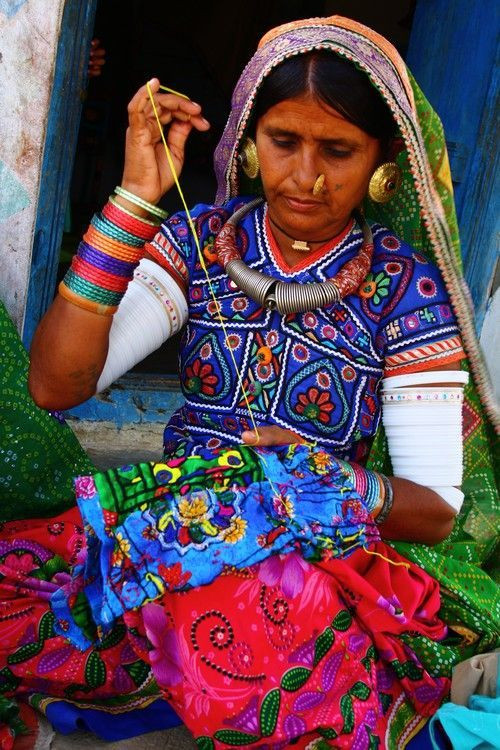The art, culture, and heritage of the state of Gujarat rank as one of the richest and most fascinating in the country. The unique and diverse cultural heritage of Gujarat attracts several tourists all-round the year.
Gujarat is remarkably renowned for its rich array of art and handicrafts, which are popular not only in the country but all across the globe. The exquisitely printed and woven clothes, pottery, beadwork, tribal art, and embroidery work resonate with the folklore and festivals of the state. People of India are fond of Gujarati jewellery, furniture, patola sarees, embroidered items, mirror work, and baked clay articles among other things.
Mata Ni Pachhedi, Ahmedabad
Mata Ni Pachhedi are sacred wall and textile art pieces that act as a backdrop for shrines. The word means “behind the Mother Goddess”. The art form has been created by the Vaghari nomads who once resided along the banks of the Sabarmati River in Gujarat.
The uniqueness of this art form involves the use of only two colours - black and red, which are made out of natural dyes. It illustrates a central deity and designs depicting nature and artistic creativities.
Meenakari Artwork, Ahmedabad
Metallic artwork is one of the signature oeuvres of Gujarat. However, the art form is not something new to the state; it dates back to the Indus Valley Civilization. Gradually, Gujarati craftsmen have evolved to be the experts when it comes to crafting with metal pieces.
‘Meenakari’ involves the art of adorning the metal pieces with intricate and detailed designs using bright colours after moulding the metals into desired shapes. Sculptures, flower vases, utensils, jewellery boxes, and ornaments are among the assortment of items that are popular in this form of art.
Sadeli, Surat
The elaborated geometric and floral patterns carved on wood, especially teak, give rise to the highly skilled technique called ‘Sadeli’. The artwork, however, bears a close resemblance to the form of Persian marquetry called ‘Khatam’.
Professionally skilled craftsmen are employed to carry out the intricate Sadeli work to the doors, windows, lamp holders, and other wooden items that heighten the house's aesthetic charm.
Bandhani, Kutch
Remarkably popular in the Kutch region, Bandhani is a tie and dye artwork. In this technique, the fabrics are twisted, tied, and dyed to yield gorgeous patterns, which are an amalgamation of dots block printed on the fabric. Red, blue, and yellow is among the colours that are predominantly used.
The artisans use organic colours and it is believed that each colour represents its own symbolism and significance.
Terracotta, Sabarkantha
The finest terracotta works can be found in the Sabarkantha district of Gujarat. Traditional terracotta sculptures can be found in several households, which lend a touch of rustic appearance to the décor.
The tribal folks of the village pride themselves on their dedicated creations. Among the sculptures, the figures of horses are most commonly found, which are often used as offerings to the local Goddess.
Mud Work, Kutch
The craft of mud work is deeply ingrained in Gujarat’s history and its popularity has spread across the world over the years. The art form represents the authentic cultural and traditional essence of the state. The highly skilled artisans illustrate their excellence through the intricate little details.
Nowadays, framed wall pieces ornamented with striking mirror work are quite in demand among the tourists as well as the locals. Hand-painted traditional clay utensils such as plates, pots, can also be found.
Pithora Painting, Chhotaudepur
Pithora painting is one of the arts that the state of Gujarat prides itself in. The wall murals are most popularly created by the ingenious artisans in the Chhotaudepur area of Gujarat as offerings to Pithora, the God of food grains. According to traditional beliefs, these paintings are made in order to seek blessings, especially during a special occasion such as weddings or childbirth.
The artisans prepare the paints by blending the pigments with milk and liquor extracted from the Mahuda trees. To create the strokes, bamboo sticks, cotton, and wooden stencils are used. With the progress of time and generation, these traditional works are not only limited to the walls but have developed into paper and canvas arts that are now sold commercially.
Rogan Painting, Kutch
Created in the form of surface embellishments, the geometrical and floral motifs have been practiced for several years. However, now only a single-family in Nirona, Kachchh is known to be practicing the art form. The special ingredient used in the paint is the extracts of castor seeds.
An iron rod with flat ends is used to paint half the design, which is then imprinted on the other half of the cloth by pressing the two halves together. The craft forms an inexpensive substitute for embroidered textiles and hence is widely used as an alternative textile for clothing.
Nowadays, these paintings are also created on cushion covers, curtains, bedspreads, kurtas, tablecloths, and wall hangings.
Picture source- Pinterest



